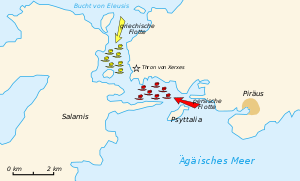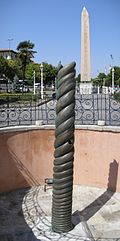Battle of Salamis
![]()
The title of this article is ambiguous. For other meanings, see Battle of Salamis (disambiguation).
Battle of Salamis
Part of: Persian Wars

Objectives: Persians: capture of Athens and conquest of Greece Greeks: Destruction or expulsion of the Persian invaders.
Persian Wars
Ark - Marathon - Thermopylae - Artemision - Salamis - Plataiai - Mykale - Eurymedon
The naval battle of Salamis took place on September 29 (23, 24, or 25 according to other sources; exact date is disputed) 480 BC between Greeks and Persians at Salamis, an island near Athens.
This battle was one of the most important naval battles in the Mediterranean in antiquity. It is considered by some historians, such as Christian Meier, along with the Battle of Marathon, as the central event in Western history, which helped to assert the history of European civilization independently against that of the East.

Monument of the warriors of Salamis

The serpent column consecrated by the victorious Greeks
Previous story
After the lost battle of Marathon (490 BC), the Persian Great King Darius I still intended to incorporate the Greek city-states into the Persian Empire. The purpose of the expansion was to fill the Persian treasury with the wealth of the Greeks on the one hand, and to create a springboard for further Persian conquests in the west on the other.
In order to bring the fleet as undamaged as possible into the battle area, the construction of a canal through the peninsula of Athos was planned. But Darius I died during the preparations for war in 486 B.C. His son Xerxes I took over the leadership of the war preparations.
The canal begun under Darius I was completed first. In addition, the Persians built two ship bridges across the Hellespont in order to advance with an army of about 70,000 to 80,000 soldiers. By 480 BC, preparations were complete and Xerxes I opened the campaign. 1000 Spartans, Thespians and Thebans, led by Leonidas, attempted to prevent the enemy's advance and turned to meet the Persian army in northern Greece, but were defeated at the Battle of Thermopylae. As a result, after three days of operations at Artemision on the northern side of Euboea, the Attic fleet was forced to retreat battered towards Athens. Xerxes was able to occupy and devastate Athens and the surrounding Attica. Now there were conflicts between Athenians and Spartans, because the Spartans wanted to defend the Isthmus of Corinth and with it the Peloponnese. The Athenians, on the other hand, relied on their fleet.
The situation seemed quite hopeless to the Greeks, especially since they were far outnumbered. To remedy the situation, Themistocles asked the Oracle of Delphi for advice. The oracle's reply was, "Take shelter behind wooden walls!" Themistocles interpreted this saying to mean that only their triremes could provide protection against the Persians; others believed that the city walls should be extended. However, Themistocles was able to convince the council to let the fleet fight the battle. The Athenian fleet had grown considerably since the Battle of Marathon, as much of Athens' resources - derived from Laureion's silver mining - had been used to build triremes. Thus the city shifted to the sea. The men were on the ships and the women and children took refuge near Salamis.
Opponent
Greeks
According to Herodotus, the Greeks had at least 271 ferryboats, of which 180 or 200 most probably came from Athens. The leadership of the fleet was in the hands of Themistocles and Eurybiades. The advantage of the Greek ferry was the greater maneuverability and speed compared to the Persian ships. Furthermore, fours possessed a ram spur with which the enemy ships could be sunk by ramming. This tactic was common to the Greeks and the Persians. Athens' fours were probably still under construction until shortly before the Persian invasion. According to Herodotus, Athens' allies sent 124 trieren and 9 penteconteres. Of the allies, Corinth was the largest force with 40 ships. From Sparta came 10 ferryboats. Since Sparta would otherwise have refused to cooperate with Athens, the Spartan Eurybiades was given supreme command of the fleet.
Persian
The Persian armed forces consisted of a large army and a fleet. Herodotus refers to 1107 fours and reports over 3000 additional ships. In total, the trier fleet is said to have consisted of 300 Phoenician, 200 Egyptian, 150 Cyprian, 100 Cilician, 30 Pamphylian, 50 Lycian, 30 Dorian, 70 Carian, 100 Ionian, 60 Aeolian, and 17 Aegean ships. However, scholars consider the number of ships to be exaggerated. According to the dominion, almost half of the crews were Greek. In order to be able to supply the land army, the invasion fleet sailed along the coast in close contact with the army. Through the channel in the Athos Mountains the Armada turned towards Thermai to follow the harbourless coast of Magnisia. Before arriving at the port of Aphetai, the fleet was caught in a violent storm and, according to Herodotus, lost about 400 ships.
Questions and Answers
Q: Who fought in the Battle of Salamis?
A: The Battle of Salamis was fought between an Alliance of Greek city-states and the Achaemenid Empire of Persia.
Q: When did the Battle of Salamis happen?
A: The Battle of Salamis happened in September 480 BC.
Q: Where did the Battle of Salamis take place?
A: The Battle of Salamis took place in the straits between the mainland and Salamis Island.
Q: Why were the Greek Allies heavily outnumbered in the Battle of Salamis?
A: The Greek Allies were heavily outnumbered in the Battle of Salamis because the Persian navy had a larger number of ships.
Q: Who persuaded the Greek Allies to bring the Persian fleet to battle again in the Battle of Salamis?
A: The Athenian general Themistocles persuaded the Greek Allies to bring the Persian fleet to battle again in the Battle of Salamis.
Q: What was the result of the Battle of Salamis?
A: The result of the Battle of Salamis was a decisive victory for the Greek fleet, sinking or capturing at least 200 Persian ships. Xerxes retreated to Asia with much of his army, leaving Mardonius to complete the conquest of Greece.
Q: What was the significance of the battles of Salamis and Plataea in the Greco-Persian wars?
A: The battles of Salamis and Plataea mark a turning point in the Greco-Persian wars because from then on, the Greek cities would take the offensive. The Persian attempts to conquer the Greek mainland were thwarted.
Search within the encyclopedia